Secrets Of Ninja Swords – Favorite Weapon Of The Shinobi
Rafael - AncientPages.com - The Ninja sword is mainly called the ninjaken, ninjato, or the shinobigatana. It is said to be the Shinobi's preferred weapon during Japan's warring period.
Numerous contemporary ninjutsu practitioners portray it as the ninja's weapon, and is usually highlighted in popular culture. Replicas of this type of weapon have been displayed at the Ninja Museum in the Mie Prefecture. At the same time, some other pieces are also exhibited at the Kouka Ninja Village Museum in the Gifu Prefecture, Japan.
Straight Blade T10 Clay Tempered Ninjato (Brass Fittings). Credit: Katanas For Sale
Historically, there was no physical proof of the existence of this type of ninja sword before the twentieth century. However, it is believed that the style and designs used for various replicas are all based on the design of the chokuto or wakizashi.
Brief Description Of The Ninja Sword
The ninja sword was commonly described as a short piece with a straight blade and was somehow similar to the Shikomizue – a concealed weapon that is either camouflaged as a cane or walking stick; the only difference between the two was that the ninja sword featured a square-shaped guard. Generally, the ninja sword was considered straight, thick, and rather heavy, while its length measured less than sixty centimeters. Although researchers still continue to dispute the existence of these blades, numerous claims suggest that the description of the weapon was based on the ninjas and their need to create their weapons themselves.
Appearance Of The Ninja Sword
The ninja swords are usually described as short swords with straight blades and square-shaped guards; the usual length of the weapon would be less than sixty centimeters, while the rest of the sword is considered thick, straight, and heavy.
Despite the disputed historical existence of these weapons, some people suggest that the standard description of the ninjato was due to the ninjas having to craft their weapons. These warriors were said to have utilized slabs of iron or steel, with its cutting-edge ground on stone. They also created their swords with straight blades since creating such was much easier than the refined and curved blades of the traditional nihontos.
Credit: Adobe Stock - patrick
Another possible reason for having such a description for the ninja sword was that these warriors were claimed to have mimicked Fudo Myo-oh, one of the Buddhist deities of the ninja clans, who was described as one who brandished a straight-bladed short sword that resembled the chokuto.
A historian named Stephen Turnbull, who specializes in the military history of Japan, described the historical ninja and their weapon. He stated that the most vital item owned by the ninja was their sword. Though the common piece was the standard Japanese katana or fighting sword, ninjas would prefer utilizing a much shorter and straighter blade for convenience.
History Of The Ninja Sword
The existence of the ninja swords in history still remains unclear, though ninjas utilized specific swords for their missions and battles. However, ninja swords during the much earlier periods had no real physical evidence since the surviving blades considered ninja swords were all crafted during the Edo period. The ninja swords utilized during Japan's warring period before the Edo period have yet to be found or acquired.
How The Ninja Swords Were Used
Ninja swords are known to be short weapons that were necessary for battling in narrow spaces and areas. It was also created mainly to stab their enemies instead of slaying them, so the ninja swords do not feature curved blades like the samurai's katana. Additionally, the function of these ninja swords was not only limited to stabbing the enemy since they could also be utilized for various purposes to allow these warriors to fulfill their missions.
A long strap measuring three meters in length was usually wound on these swords, and its big square-shaped guard had a specific purpose. It was utilized for climbing walls: first, the ninja would lean their weapon against a wall before holding the strap firmly. The ninja then puts one foot on the sword's guard and pushes up to reach the top of the wall. Once on the wall, the ninja would pull the weapon up using the strap and could wait and spy on enemies below.
The strap could also be utilized in different situations: when a ninja lurks and spies in a room, he ties the end of the strap on a door and then stretches it right across. When the enemy enters, the ninja can trip him and allow the ninja to assault an attack. The strap can also be used as a bandage to stop bleeding if the ninja gets injured. It is what makes the ninja swords unique since they can be utilized in various ways, unlike the samurai swords, which were only used for killing the enemy.
Shinobi No Mono: The Shadow Warriors And Hattori 'The Demon' Hanzo Of Ancient Japan - Read more
Another interesting point about the ninja sword is that the weapon takes a different shape than a sword. Ninjas sometimes use a walking stick or cane that generally conceals the blade, which is necessary for emergencies. It is also handy for undercover missions since enemies will not suspect that a ninja is around; they usually disguise themselves as older people or weak and sickly individuals, the disabled, or even wounded people.
The Modern Ninja Swords
Like the classic ninja swords, the modern ninja blades appear straight with a square-shaped guard, but this appearance is still not historically accurate due to the limited finds of such weapons. According to Hatsumi Masaaki, founder of the Bujinkan Organization, the ninja swords were much straighter compared to the familiar swords available during Japan's warring period. Its blades were still slightly curved but less prominent than the katana's.
Nowadays, ninja sword replicas are being sold as decorative or functional pieces; plus, the weapon has also appeared in a couple of popular video games and films.
Written by – Rafael - AncientPages.com Contributor
Updated on Oct 16, 2023
Copyright © AncientPages.com All rights reserved. This material may not be published, broadcast, rewritten or redistributed in whole or part without the express written permission of AncientPages.com
Expand for referencesMore From Ancient Pages
-
 New Egyptian Dinosaur Helps To Reconstruct Evolution Of Dinosaurs In Africa
Archaeology | Jan 30, 2018
New Egyptian Dinosaur Helps To Reconstruct Evolution Of Dinosaurs In Africa
Archaeology | Jan 30, 2018 -
 Traces Of Ancient Maya In Europe? Controversial Theory Examined
Ancient Mysteries | May 25, 2018
Traces Of Ancient Maya In Europe? Controversial Theory Examined
Ancient Mysteries | May 25, 2018 -
 Why Did Ancient Romans Build So Many Straight Roads?
Ancient History Facts | Aug 9, 2017
Why Did Ancient Romans Build So Many Straight Roads?
Ancient History Facts | Aug 9, 2017 -
 Scylla And Charybdis – Legendary Greek Sea Monsters – Choosing The Lesser Of Two Evils
Featured Stories | Jan 15, 2021
Scylla And Charybdis – Legendary Greek Sea Monsters – Choosing The Lesser Of Two Evils
Featured Stories | Jan 15, 2021 -
 Four Magical Treasures Of Tuatha De Danann
Celtic Mythology | Jan 23, 2023
Four Magical Treasures Of Tuatha De Danann
Celtic Mythology | Jan 23, 2023 -
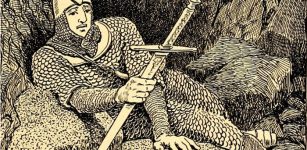 Durendal – Magical Sword Of Knight Roland That Cut Stone Boulders With A Single Strike
Featured Stories | Jan 19, 2022
Durendal – Magical Sword Of Knight Roland That Cut Stone Boulders With A Single Strike
Featured Stories | Jan 19, 2022 -
 Legend Of The Eight Immortals Who Know The Secrets Of Nature
Chinese Mythology | May 21, 2016
Legend Of The Eight Immortals Who Know The Secrets Of Nature
Chinese Mythology | May 21, 2016 -
 Neanderthals Buried Their Dead And Developed Spirituals Beliefs – Did Neanderthals Practice Religion?
Featured Stories | Dec 28, 2016
Neanderthals Buried Their Dead And Developed Spirituals Beliefs – Did Neanderthals Practice Religion?
Featured Stories | Dec 28, 2016 -
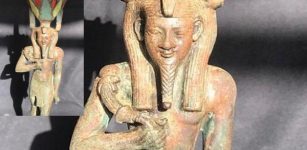 Carved Statue Of God Nefertum Unearthed In Egypt’s Saqqara Necropolis
Archaeology | Oct 3, 2020
Carved Statue Of God Nefertum Unearthed In Egypt’s Saqqara Necropolis
Archaeology | Oct 3, 2020 -
 First Americans Reached The Continent 15,000 Years Earlier Than Previously Thought – Chiquihuite Cave Reveals
Archaeology | Jul 22, 2020
First Americans Reached The Continent 15,000 Years Earlier Than Previously Thought – Chiquihuite Cave Reveals
Archaeology | Jul 22, 2020 -
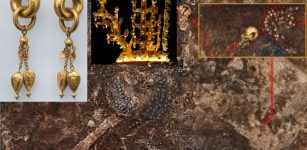 South Korea’s Silla-Era Tombs Reveal More Priceless Jewelry
Archaeology | Sep 9, 2020
South Korea’s Silla-Era Tombs Reveal More Priceless Jewelry
Archaeology | Sep 9, 2020 -
 Ancient Marble Statue Of Sphinx Discovered In Tang Dynasty Tomb
Archaeology | Dec 16, 2015
Ancient Marble Statue Of Sphinx Discovered In Tang Dynasty Tomb
Archaeology | Dec 16, 2015 -
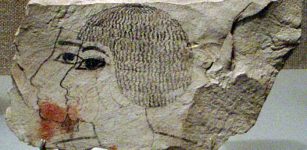 Tomb Of Senenmut And Earliest Known Star Map In Ancient Egypt
Civilizations | Nov 17, 2016
Tomb Of Senenmut And Earliest Known Star Map In Ancient Egypt
Civilizations | Nov 17, 2016 -
 Unorthodox Ancient ‘Out-Of-This World’ Carvings Were Found And Destroyed – Mysterious Labyrinth And Unknown Ruins – Part 2
Ancient Mysteries | Aug 13, 2020
Unorthodox Ancient ‘Out-Of-This World’ Carvings Were Found And Destroyed – Mysterious Labyrinth And Unknown Ruins – Part 2
Ancient Mysteries | Aug 13, 2020 -
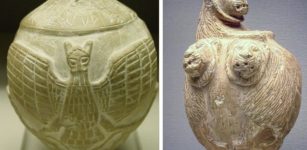 ‘Stone Club Head Of Mesilim’ Probably The Most Powerful Sumerian Ruler At That Time
Artifacts | Oct 12, 2017
‘Stone Club Head Of Mesilim’ Probably The Most Powerful Sumerian Ruler At That Time
Artifacts | Oct 12, 2017 -
 Saint George: Knight Warrior Who Refused To Denounce His Faith And Died A Martyrs Death
Featured Stories | Jun 3, 2019
Saint George: Knight Warrior Who Refused To Denounce His Faith And Died A Martyrs Death
Featured Stories | Jun 3, 2019 -
 6,000-Year-Old Bizarre, Mouthless ‘Alien’ Mask Unearthed In “The Salt Pit” Settlement In Northeast Bulgaria
Archaeology | Nov 20, 2020
6,000-Year-Old Bizarre, Mouthless ‘Alien’ Mask Unearthed In “The Salt Pit” Settlement In Northeast Bulgaria
Archaeology | Nov 20, 2020 -
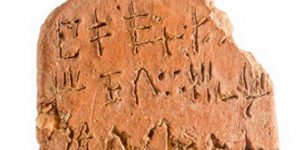 New Clues To Minoan Writing System
Archaeology | Sep 10, 2020
New Clues To Minoan Writing System
Archaeology | Sep 10, 2020 -
 Early Christian Crypt Unearthed In Zaldapa Fortress, Bulgaria
News | Sep 7, 2015
Early Christian Crypt Unearthed In Zaldapa Fortress, Bulgaria
News | Sep 7, 2015 -
 2,ooo-Year-Old Ancient Roman Treasure Found Underwater Of The Coast Of Portofino, Italy
Archaeology | Jan 31, 2019
2,ooo-Year-Old Ancient Roman Treasure Found Underwater Of The Coast Of Portofino, Italy
Archaeology | Jan 31, 2019



